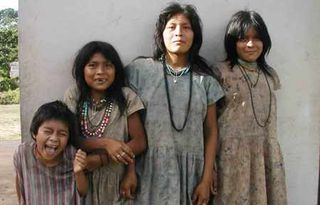Study on Bolivian tribe shows heart attack and stroke are modern illnesses
August 10, 2009 - Los Angeles Times
Heart attacks and strokes are an artifact of sedentary lifestyles and bad eating habits, according to a new study of a primitive Amazonian tribe called the Tsimane. The findings, reported today in the online journal PLoS One, suggest that our ancestors probably did not suffer from such problems to any significant extent and that heart attacks and stroke are largely modern illnesses.
 (left) Members of a Tsimane village from the Beni province of Bolivia. Photo: Michael Gurven, UC Santa Barbara
(left) Members of a Tsimane village from the Beni province of Bolivia. Photo: Michael Gurven, UC Santa Barbara
The Tsimane are a group of perhaps 6,000 indigenous people that live in the Beni province of Bolivia, mostly along the banks of the Maniqui River. They cultivate plantains, manioc, corn and rice, and they fish, hunt and gather wild berries to supplement their diet. They also grow and harvest their own tobacco and ferment manioc and maize to produce alcohol. Their average life expectancy is only 43 years, with half dying from infectious and parasitic diseases, such as parasitic worms and pathogenic protozoa. Anemia is present in a large fraction of the people and growth is stunted. Obesity is rare to nonexistent.
 (left) Women from the village Photo: Michael Gurven, UC Santa Barbara
(left) Women from the village Photo: Michael Gurven, UC Santa Barbara
Anthropologist Michael Gurven of UC Santa Barbara and his colleagues have been studying the Tsimane since 2001. With Dr. Eileen Crimmins of the USC Davis School of Gerontology, they have been looking at predictors of heart disease, such as hypertension, obesity, diet and smoking habits in the population.
Previous studies in smaller groups have suggested that the active lifestyle and lean diet of indigenous peoples protects them from heart disease, but such conclusions have been
limited by the small number of people remaining in such populations. The Tsimane population is large enough that it can provide reliable statistics, but small enough that the team was able to study a large fraction of the people older than 40, Crimmins said.
 (left) Fishing provides the mainstay of the Tsimane diet. Photo: Michael Gurven, UC Santa Barbara
(left) Fishing provides the mainstay of the Tsimane diet. Photo: Michael Gurven, UC Santa Barbara
The team studied 259 people older than 40 in 15 villages, measuring a variety of factors that are thought to be related to heart disease. They found that the Tsimane elders had unusually high levels of inflammation and of C-reactive protein, both of which are thought to be predictors of heart disease. They also had low levels of high-density lipoprotein or HDL, the so-called good cholesterol. Nonetheless, none of the Tsimane they studied had peripheral artery disease -- a stiffening of the arteries that is a powerful predictor of heart attacks and strokes. Only 3.5% of those older than 40 had high blood pressure, and only 23% of those older than 70.
They concluded that inflammation and C-reactive protein levels may increase the likelihood of heart disease, but that they can be offset by a healthy metabolism, an active lifestyle, lean diet, low blood lipids and a favorable body mass. Tsimane men in their 40s spend an average of 850 more calories per day than American males, and women expend 450 more. Because the Tsimane diet and activity levels are similar to those of our ancestors, the team believes that the latter group also suffered very little from heart disease.
One other factor that might be important in the Tsimane is the chronic infection by parasitic worms such as hookworms. Some studies have suggested that the worms can reduce cholesterol levels in the blood. They may also stimulate the production of anti-inflammatory cytokines that protect blood vessel walls from injury. If they are a contributor, however, that is a very high price to pay for protection against heart disease.
-- Thomas H. Maugh II